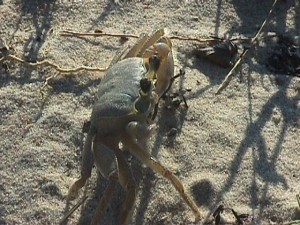For locals along the coast ghost crabs are as common as mockingbirds and mourning doves. Before Ivan, when the dunes were larger and closer to the road, viewing the white crabs scouring across the road at night in your headlights forced all into defensive driving maneuvers. And for those who have ever tried to catch one, all would agree it is one of the fastest animals on the beach.

Ghost crabs (Ocypode quadrata) are members of the fiddler crab family. Like their fiddler crab cousins, they are more terrestrial than aquatic and dig burrows to protect themselves from predators and the intense heat of the midday sun. Though ghost crabs can be found in a variety of locations on the island, they are most frequently found between the mean high tide line and the upper portions of the primary dune line; typically on the Gulf side. Their “J” shaped burrows reach the water level below the sand and can run as deep as four feet. Larger individuals can dig deeper burrows and are often found further away from the water’s edge. These are crabs and thus still possess gills. Gills must be in contact with water in order to obtain needed oxygen. To do this ghost crabs have a gill chamber that will hold water for periods of time. The crabs can obtain water either at the bottom of their burrow or by running to the edge of the Gulf. And running is a good term for what they do. Once they have left the burrow they will lift five of their 10 legs above their head running on the remaining five. Running sideways they will have three in contact with ground in the direction they are going and two on the opposite side; if you look closely you can actually the remaining legs raised high in the air. When they tire, they will stop, make a 180° turn, and begin running again; resting their legs. They have reached speeds of 1.6 meters/second, which is 3.5 mph!
Ghost crabs are most active at night, though they are found at dawn and dusk and occasionally at midday. They feed on invertebrates at the surface zone such as mole crabs (sand fleas) and coquinas (bean clams). Dead fish and other animals found along the shoreline are also part of their diet, often dragging them back to their burrow. Unfortunately they are one of the predators of sea turtle hatchlings heading to the Gulf at night. Ghost crabs breed in late spring and early fall. The females will carry her developed eggs to the surf zone to release them. The developing young will return the following spring to mate and release their own eggs. Females may produce eggs in their second year but rarely live to do the same the third year. They are quite social with other crabs communicating, like their fiddler crab cousins, with body postures and claw movements. They are most active from March to December, plugging the entrance of their burrows and going dormant during the colder months of the year.
There has been concern about the impact of the oil spill on their numbers and the numbers of their prey, mole crabs and coquina. Our beaches did have small and large patches of oil that seeped down into the sand and then there were the methods used to remove the oil from the beach. At this point we do not know how hard their populations were impacted but scientists have collected data before and after the spill and are analyzing this now. However low their population dropped I am sure these resilient creatures will rebound and we will once again dodge them during our evening drives.
 1
1
